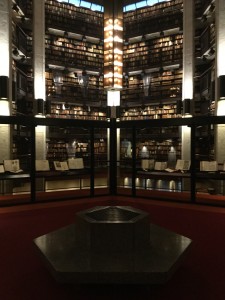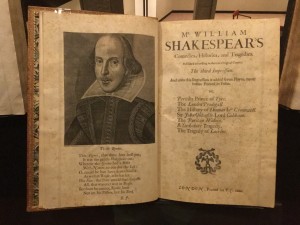As a group, we brought together all the spaces on campus that interested us, and devised an initial route to investigate. Our criteria was fairly open – we were just aiming for a roughly 30-60 minute walk, but this could have taken the form of a ‘micro-walk’ within a single space, such as the Fisher Library (one of our participants had suggested the possibility of meandering among the books, looking for select titles or passages); or a more traditional multi-site walk, which is what the group eventually selected. We laid out a walk that was fairly logical, but also alternated often between noisy and quiet spaces.
The route we opted for is as follows:
- The Hart House Library
- Corridors within the Hart House Building
- Corridors within the University College Building
- The Green Space in Front of the University College Building (UC Green)
- The Chapel Inside Knox College
- The Inner Courtyard at Knox College
- A Short Walk up St George St from Knox College to the Fisher Library
- The Fisher Library
Our route would begin and end within libraries, and contained different types of ‘quiet’ spaces, including the Knox Chapel, the courtyard inside Knox College (outside, but protected by stone architecture), and the UC Green, which is never completely quiet, but is still relatively peaceful, given its location in the middle of Toronto.
Once the route was mapped out, we began with a first pass through the spaces with digital recorders (in next week’s post, we’ll discuss the technological equipment we used). Spaced out by intervals of about 5-10 minutes, three of us walked through each of the spaces consecutively, recording the sounds that happened to live in them that day. We recorded about 5-6 minutes of material, which would make for a roughly 40 minute walk (8 spaces X 5 mins), and would potentially allow us to evenly intermix recordings, if that’s how we eventually decided to use them.
The experience of surreptitiously (or somewhat surreptitiously – the recorders aren’t particularly inconspicuous) recording the audio of a space is strangely transformative. The very act of holding a recorder – even if the ‘record’ function isn’t active – heightens one’s sense of the audio in a space. You immediately become aware of the slightest sonic disturbances, and are also surprised by the amount of activity that you aren’t usually registering. At various times, each of us felt the desire to bias the recorded material by moving closer or further from different sounds. We also often felt as if we were spying on others, or even stealing audio material – as if the public sounds were assumed to contain their own innate right to privacy. It recalls on-going debates around cellphone cameras, CCTV recordings, and online surveillance. Where does the boundary between private and public lie today? Home is no longer the guaranteed refuge it once was, and we increasingly behave under the assumption that someone (an authority figure or otherwise) could be listening or watching.
We will go into the details of specific spaces in future posts, but as a general introduction, the sounds we often picked up included everyday audio from footsteps and conversations, to keys jangling and papers rustling. There were also surprises, however, such as a Shakespeare lecture in the Fisher library (photo below), which killed our expectations of a silent space.

